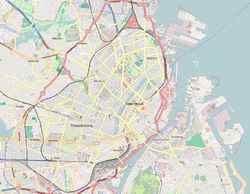| Nusrat Djahan Mosque | |
|---|---|
Nusrat Djahan Moske | |
 | |
| Religion | |
| Affiliation | Ahmadiyya Islam |
| Ecclesiastical or organisational status | Mosque |
| Status | Active |
| Location | |
| Location | Hvidovre, near Copenhagen |
| Country | Denmark |
Location of the mosque on the outskirts of Copenhagen | |
 | |
| Geographic coordinates | 55°39′3.53″N12°28′44.26″E / 55.6509806°N 12.4789611°E |
| Architecture | |
| Architect | John Zachariassen |
| Type | Mosque |
| Groundbreaking | 6 May 1966 |
| Completed | 1967 |
| Specifications | |
| Capacity | 120 worshipers |
| Dome | 1 |
The Nusrat Djahan Mosque (Danish : Nusrat Djahan Moske) is an Ahmadiyya mosque located in Hvidovre, on the outskirts of Copenhagen, Denmark. Completed in 1967, it was the first mosque in Denmark. The mosque was financed solely by the female members of the Ahmadiyya Muslim Community. The capacity of the mosque is 120 worshipers. [1]
Contents
The mosque is named after Nusrat Jahan Begum, the second wife of Mirza Ghulam Ahmad, the Promised Messiah and Mahdi. [2]
